(a failed experiment)

| E-Com Mail
(a failed experiment) |
 |
| E-Com Mail(click here) | Look-a-Likes(click here) | Stampsjoann (click here) |
Some forerunners
Before the official establishment of E-COM mail on January 4, 1982,
there were numerous attempts to combine the immediacy of electronic transmission
of information with permanency of hard copy communications.
Early telegraph messages were often sent electronically to a city near the recipient and then printed and delivered by US Mail. Even in 1934 I'm sure Mom much preferred the following to an operator's voice over the telephone... if Mom even had a phone in her home...
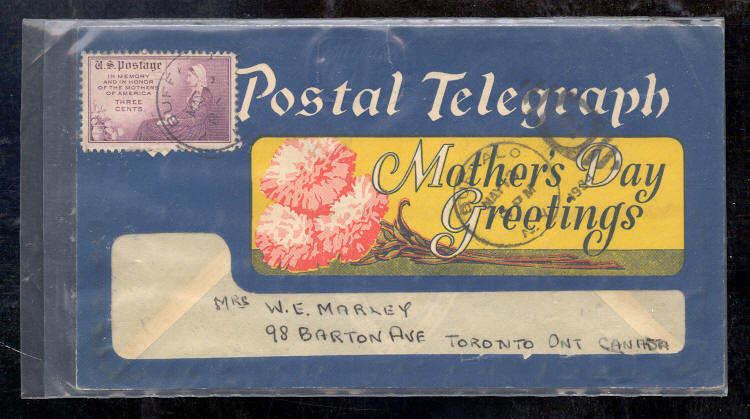 |
On October 17, 1960, the United States Post Office initiated live transmission of what was called Speed Mail. Speed Mail transmitted government correspondence to other government agencies using high speed equipment. A one page document could be sent in one second from Washington DC to Chicago. This experiment, using facsimile (FAX) technology, lasted six weeks and was considered successful. Postmaster Arthur Summerfield then envisioned the use of Speed Mail for the bulk of First Class mail throughout the country. In late February 1961, the Speed Mail project was discontinued when the newly elected Kennedy administration succumbed to pressures, primarily from Western Union, which contended that USPS was unfairly competing with services provided by private sector companies.
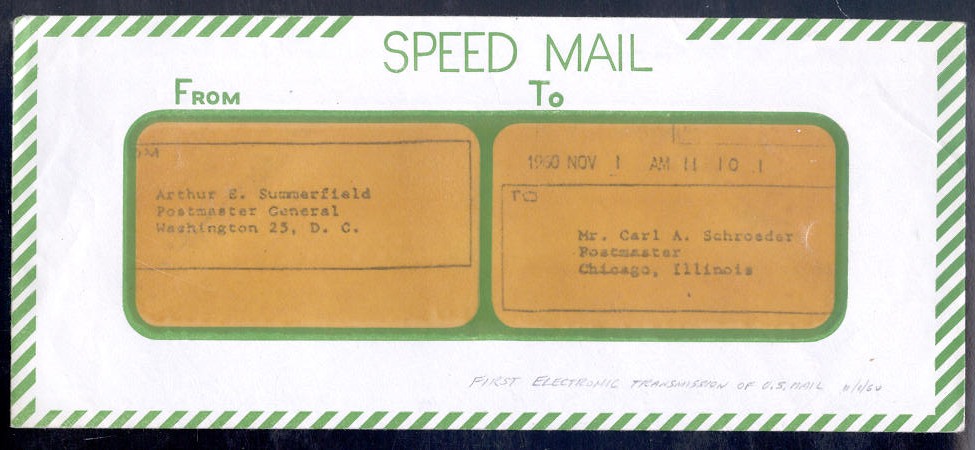
(Click image for 300 dpi scan) |
The letter enclosed, signed by Postmaster Summerfield, boasts of this electronic transmission as a "mile post" to the "progress of next day delivery of mail anywhere in the United States". The letter is "printed" on what resembles early thermographic paper.
|
|
Included in the Speed Mail envelope was a card to be returned evaluating the quality of the tranmission.
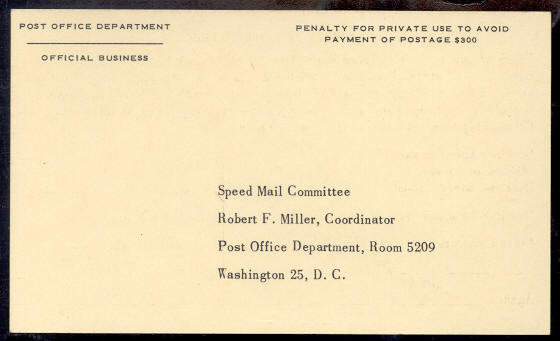
(Click image for 300 dpi scan) |
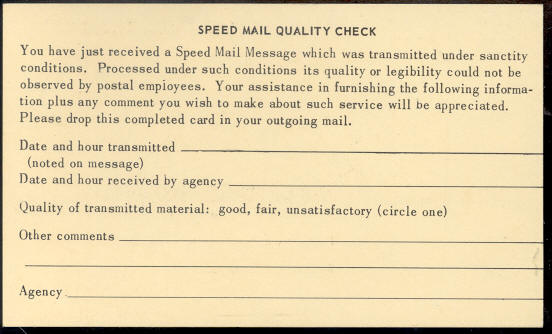
(Click image for 300 dpi scan) |
Beginning in November 1971, using similar but more readily available technology, Facsimile Mail Service was tested by the United States Postal Service and was reported to have been designed as a forerunner of other advanced communications technology. This test was not limited to communications between governmental agencies. It allowed a postal customer to send a private letter. Again, there is little information in the philatelic literature about this experiment other than anecdotal remembrance from several collectors who thought they saw FAX machines in some post offices, this at a time when FAX machines were not widely available in every private office .
Thanks to Steve Unkrich, there now is information on the location
and pricing for this experimental service.
Click below for...
+ Brochure page 1
+ Brochure page 2
Although facsimile transmission was successful, albeit very expensive,
the service was terminated due to a change in management at the Postal
Service.
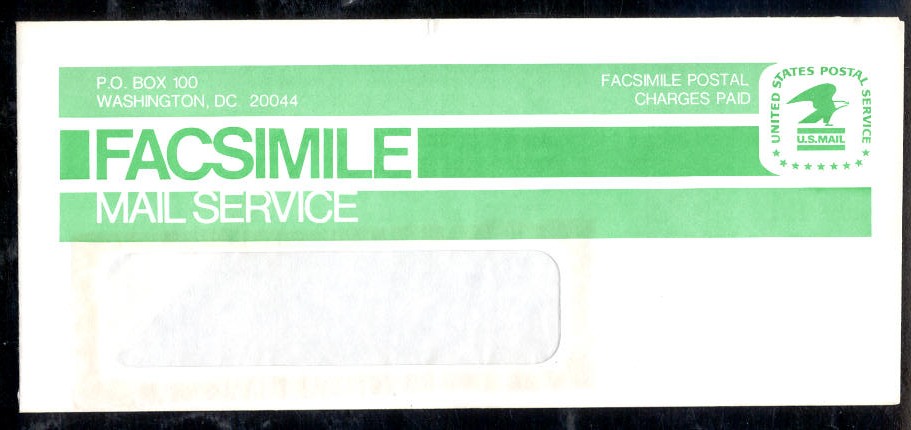 |
The true predictor of what would become E-COM mail was the formal alliance between the United State Postal Service (USPS) and the Western Union company. This alliance signaled the birth of Mailgram. Western Union would handle the electronic transmissions and the USPS would deliver hard copy letters.
Although examples are known from 1972, the earliest Mailgram I have been able to locate is from 1973.
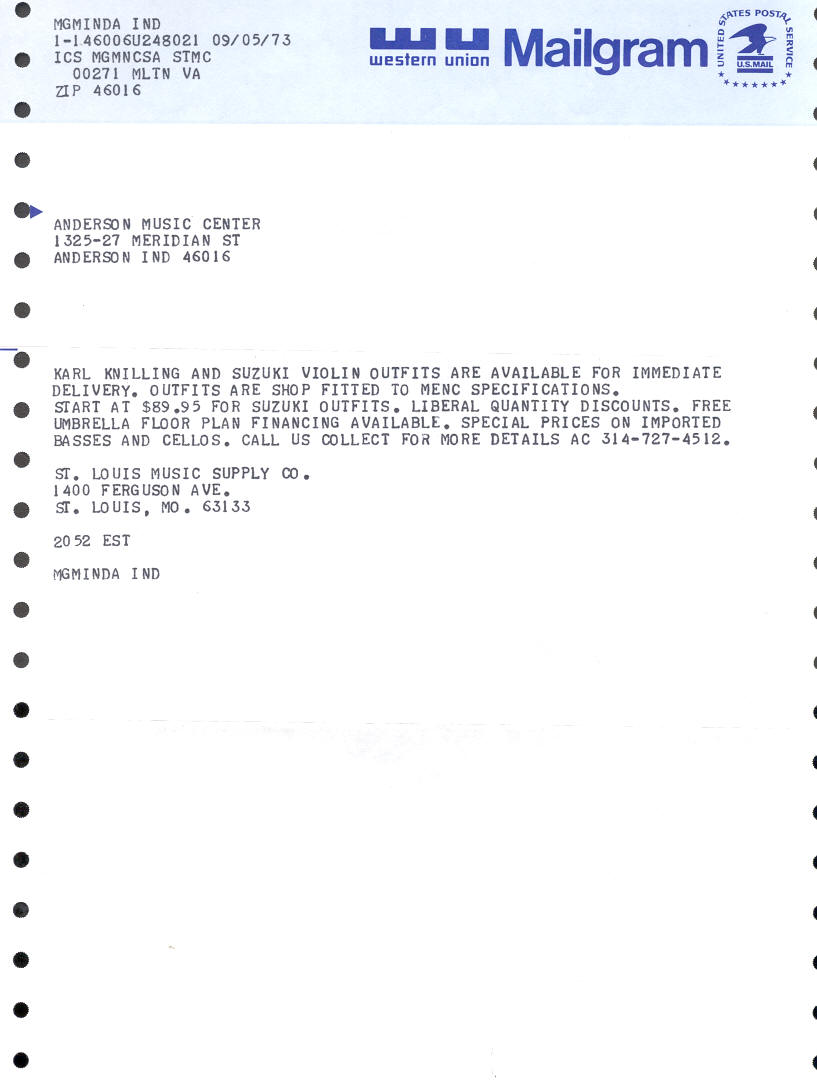 |
On April 13, 1974 the Westar communications satellite was launched for use in transmitting future Mailgram messages. Even before the satellite launch, the USPS Philatelic Merchandising Division Office of Stamps used a Mailgram to announce the availability of special cachets/letters marking the planned September 6th first official use of the Westar for Mailgram transmissions. An example can be seen <here> The outgoing envelope for this letter can be seen by clicking <here>
A July 1974 letter from the Orlando Florida Postmaster confirming a collector's order of these first official Westar transmission items can be seen by clicking <here>
After the September 6th successful transmissions, the collector received
+ the Mailgram <here
>
+ in the envelope shown <here
>
+ and also a cover commemorating the launch
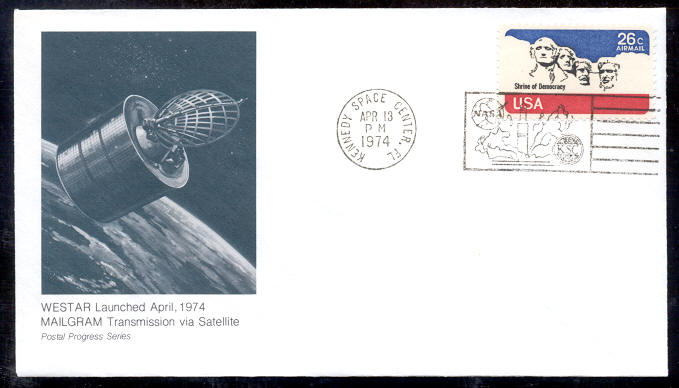 |
A typical commercial use of a Mailgram from 1982, can be seen <here> along with its accompanying outgoing envelope which is shown <here>
The latest use of a Mailgram in my collection is from 1992 as shown <here> This letter not only has a new style printing, letterhead and outgoing envelope (<here >) but is also two pages long as shown <here>
Other styles of outgoing envelopes are <here > and <here>
In 1975, Al "Tag"" Boerger described Mailgrams in his Handbook on US Luminescent Stamps <here> and <here>
Click on links below for more information on E-Com.
| E-Com Mail(click here) | Look-a-Likes(click here) | Stampsjoann (click here) |